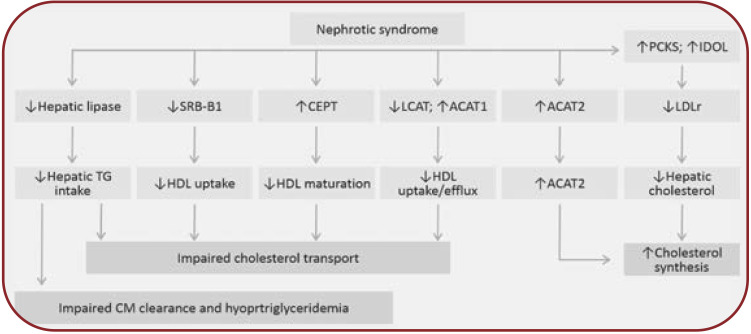FIGURE 1.
Pathogenesis of hyperlipidemia in the nephrotic syndrome. ACAT-2=acyl-CoA cholesterol acyltransferase-2; CETP=cholesteryl ester transfer protein; CM=chylomicrons; LCAT=lecithin cholesterol acyltransferase; LDLr=LDL receptor; SR-B1=class B scavenger receptor type 1; TG=triglyceride. The main mechanisms of hypercholesterolemia include the increase in hepatic cholesterol synthesis and impaired reverse cholesterol transport, and for hypertriglyceridemia, impaired triglycerides uptake. (i) Increased hepatic cholesterol synthesis is stimulated by the low intracellular level of free cholesterol induced by the increased expression of PCSK9 and INDOL (which reduces LDL hepatic uptake by degrading the LDLr) and by the increase in cholesterol acylation by activated ACAT2. (ii) The reverse cholesterol transport to the liver is altered as a result of reduced HDL-mediated extraction of cholesterol from lipid-laden cells by heavy urinary loss of LCAT and increased ACAT-1 expression. Moreover, the marked increase in serum CETP impairs HDL maturation, and the marked reduction of SR-B1, an HDL docking receptor, limits HDL uptake by the hepatocyte. The altered reverse cholesterol transport promotes atheroma plaque organization. (iii) The reduced activity of hepatic lipoprotein lipase affects chylomicron (CM) clearance and contributes to the development of hypertriglyceridemia.

